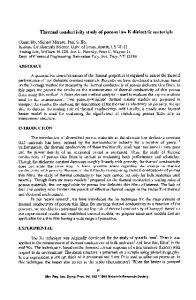Thermal rectification of porous semiconductor materials
- PDF / 3,592,505 Bytes
- 6 Pages / 612 x 792 pts (letter) Page_size
- 102 Downloads / 361 Views
Thermal rectification of porous semiconductor materials Brian L. Geist1, Madrakhim Zaynetdinov1, Kirby Myers2, Hans D. Robinson2 and Vladimir Kochergin1 1 MicroXact, Inc., Blacksburg, VA 24060-6376, U.S.A. 2 Department of Physics, Virginia Tech, Blacksburg, VA 24061, U.S.A. ABSTRACT Thermal rectification in nanostructured materials is an active topic of research and development. Here it is suggested that porous semiconductor materials can offer an unmatched tailoring of its structural properties, resulting in both the ability to study the effects of nanoscale morphology on thermal rectification phenomenon, and the perspective to achieve large thermal rectification over a wide temperature range in combination with other beneficial properties, such as a wide tunability of thermal conductivity, or optical transparency of the thermally rectifying structure. In this contribution we are presenting the first to our knowledge experimental demonstration of thermal rectification in mesoporous silicon. The influence of pore morphology controlled via Si substrate crystallographic orientation and etching conditions on thermal rectification are studied. The effect of oxidation of the porous material is presented as well. Experimental results are further compared with several recently published theoretical predictions of thermal rectification in similar structures. INTRODUCTION Thermal rectification is characterized by the dependence of thermal transport along a specific axis upon the sign of the temperature gradient or heat current. It was observed or suggested in a number of different structures since first encountered by Starr in 1935. [1] The subject was thoroughly reviewed recently by Roberts and Walker. [2] However, despite the wide range of materials and structures where the phenomenon was observed, the practical applications of thermal rectifiers are lagging behind. The reason is that thermally rectifying systems reported to date are offering either limited levels of rectification, limited temperature range of operation, or require very expensive fabrication techniques and are therefore not suitable for the largest potential applications of thermal rectification technology. A number of theoretical proposals were made to utilize various nanoscale thermal rectification effects, e.g., a ballistic rectifier relies on asymmetric scattering of energy carriers, as has been suggested for phonon transport in a sawtooth nanowire, [3] nanowires with special surface specularity functions [4] or asymmetric nanostructures. [5] However, the practical applications of such materials are not straightforward due to complexity and expensiveness of the fabrication process (that involves e-beam patterning, reactive ion etching and other complex and pricy techniques incompatible with the fabrication of bulk materials). In this contribution we propose to utilize natural nanoscale anisotropy of certain porous semiconductor materials that can be easily and inexpensively fabricated in bulk quantities and that the anisotropy of the pore structure can
Data Loading...






